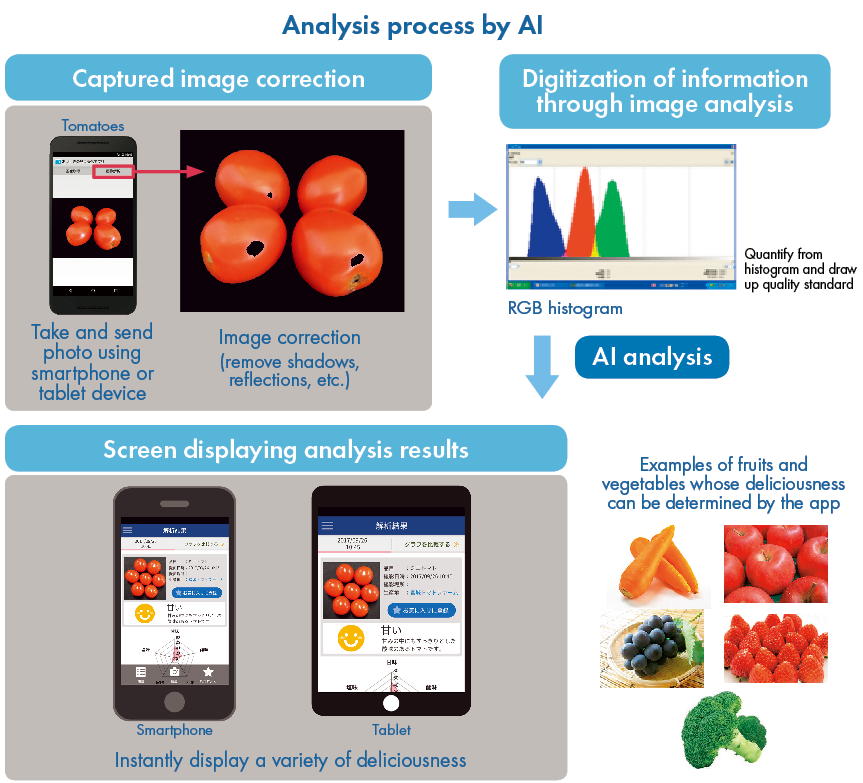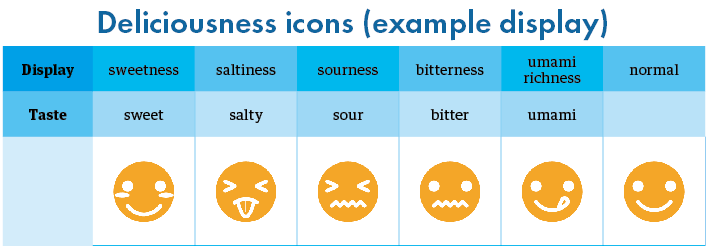May 2021
Visualizing Deliciousness

A technology has been developed that enables the deliciousness of fruits and vegetables to be “quantified” and viewed simply by photographing them with the camera of a smartphone or tablet device.
The moment fruits or vegetables are photographed with the camera of a smartphone or tablet device, numerical values related to flavor are displayed instantly as a graph. The developer of this “deliciousness visualization” technology is Makuta Takehiro, president of Makuta Amenity Co., Ltd. of Date City, Fukushima Prefecture, and his research group.
The distinctive feature of the technology is that it determines the taste of agricultural produce based on subtle differences in color that are difficult to be distinguished by the human eye. The technology is very easy to use. All that is required is to place the fruits or vegetables on a black background, take a photo with the camera of a smartphone or tablet device equipped with the dedicated application, and press the analysis button on the app. In a matter of seconds, a radar chart showing the distribution of the five basic tastes (sweet, salty, sour, bitter and umami*) and an analysis such as “Sugar content approximately 4.6 percent. Sour. Has a sour taste” are displayed on the screen.
“For example, a certain color of crops is determined by pigments such as anthocyanins and carotenoids. Anthocyanins producing red coloring are associated with sweetness, while carotenoids producing yellow coloring are associated with umami. We use this correlation to analyze the taste of fruits and vegetables based on their color,” says Makuta.
The captured image data is separated into its red, green and blue components (the three primary colors of light), and represented digitally as an RGB histogram. The AI, which has memorized the wavelength of each color of light, compares this data with a database of taste information to instantly analyze and display the deliciousness of the food.
The AI is stored in the cloud (server). So long as there is a communication environment capable of displaying the data via terminals, the system can be used anywhere in the world by localizing it according to needs such as language.
There are other ways to quantify and display the deliciousness of agricultural produce, such as measuring the juice content collected or using taste sensor devices, which are large and expensive. The time, effort and cost involved have made it difficult for ordinary farmers and stores to adopt these methods. Makuta Amenity’s system has the advantages of being inexpensive to adopt, easy to operate because it is smartphone-enabled, and safe to operate without damaging the produce whether at the time of shipment or at the store.
“This system allows producers to demonstrate the deliciousness of the produce they ship in a more concrete way. What’s more, retailers and restaurants will be able to create and offer consumers recipes that utilize the unique flavor of each fruit and vegetable.”
Makuta’s business started out distributing organic agricultural produce from Fukushima Prefecture to the Tokyo metropolitan area. However, from early on as the business developed, Makuta became aware of the challenges of the agricultural produce distribution system. There is a strong tendency for most crops to be priced according to balance of supply and demand, or size and shape. This means that small or misshapen produce is sometimes sold cheaply or discarded even if it tastes good. Makuta became increasingly keen to create a system that would better reward producers who shipped produce that is not only visually appealing but also offers high added value in terms of flavor. The system also helps consumers to make informed product choices.
Makuta embarked on research over ten years ago, sparked by a meeting with a researcher from the Yamagata University Graduate School Management of Technology Office who had the idea of determining taste by color analysis. The idea was selected by the Ministry of Economy, Trade and Industry (METI) as a subsidized project, and the funds were used to launch a research project to compare the color related data of four kinds of vegetables (cucumbers, cherry tomatoes, komatsuna [Japanese mustard spinach] and spinach) with the analysis data obtained using the test equipment, and also the taste data from actual consumption. The findings showed a stronger than expected correlation between the color data and the taste data, and the commercialization of the “visualization of deliciousness” technology began in earnest.
A sizable database of food taste data has now been constructed for fourteen vegetables (including broccoli, cabbage and carrots) and five fruits (Tochiotome strawberries, Fuji apples, cherries, grapes of the Kyoho and Shine Muscat varieties, and satsuma mandarin [Citrus unshiu]). There are plans to gradually increase the number of food items in the database.
Says Makuta, “Producers and retailers want different information, so we want to devise ways to customize the data according to the application. The addition of functional data such as nutrients will make the database even more useful. By developing the system further, I’d like to create a healthy supply chain where high value-added agricultural produce is valued fairly. I hope to make use of it in emerging countries where the distribution infrastructure is undeveloped.”
“Deliciousness visualization” AI technology has the potential to achieve the stable distribution of high-quality, flavorsome fruits and vegetables, cutting down on the amount of produce that is discarded on the basis of poor visual appeal alone.
* Umami is a savory taste sensation that is produced by several amino acids and nucleotides found in food.



